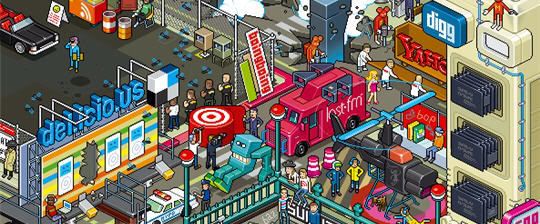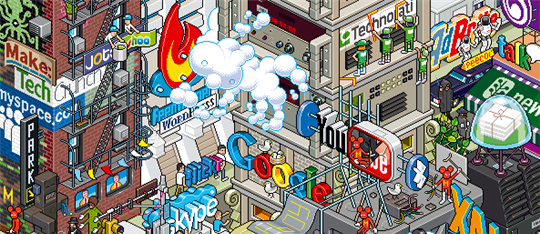http://www.cbt.eduSteven Snell on Dec 27th 2008Photoshop is an incredible tool for graphic design, but there is certainly a lot to learn for new designers, and there’s always more to master for those who are already experienced. If you’re currently working as a designer and looking to improve your skills, you probably find that time is a major constraint to improving your abilities.
If so, you’ll need to develop a plan to improve your skills step-by-step in the time that you have available. If you’re an aspiring designer, you may have no idea where to start in order to achieve the level of success of some of the Photoshop masters that we see online. In this, article we’ll look at ten steps you can take to progressively build your skills using resources that are readily available.
1. Follow Tutorials
Psdtuts+ is obviously focused on providing excellent quality tutorials for readers. Like Psdtuts+, there are a growing number of other websites and blogs that regularly publish Photoshop tutorials. All of these sites are valuable resources for improving your skills, whether you’re looking to develop specific skills or just looking to improve in general.
In order to take advantage of the tutorial sites that are available, subscribe to a few that you like the most so you don’t miss out on new posts (you may also want to bookmark other tutorial sites in case you want to find them in the future). With the amount of content that is published, you’ll never be able to work through each tutorial, and you’re unlikely to have an interest in all of them anyway.
Try to get in the habit of picking one or two per week to attempt on your own. For most of us, learning is much easier when we’re actually doing something ourselves, so working through the tutorials is essential rather than just browsing through them. If you use Google Reader you can star the tutorials that interest you the most so you’ll be able to easily find them when you have some spare time.
About six months ago Collis published a list of his favorite tutorial sites, which included: Tutorial9, PS Hero, Tutzor, PhotoshopStar, Tutorial Dog, Abduzeedo, PhotoshopGUIDesign, Worth1000, Digital Grin, and Photoshop Support. In addition to Collis’ list, PSD Learning, PSDFAN, PhotoshopTutorials.ws, and Photoshop Essentials are also good resources.
2. Experiment
The best way to learn anything new is to experience it for yourself. While following tutorials can be incredibly helpful, you should also take some time to just experiment on your own to see what you can create. You can try to apply things you have learned from tutorials, or just experiment with things you’re not familiar with. Photoshop has so many different functions, features and settings that you’ll really need to become familiar with them in order to understand their potential.
Free form experimentation can open up your creativity and help you to get more comfortable with Photoshop. In order to ever be able to put the lessons you learn from others into practice in real world scenarios, you’ll need to be able to do some experimentation and adaptation. There may be some tutorials that teach you exactly what you need to do, but more likely they’ll teach you a skill or technique that can be used on your own projects, but you’ll need to adjust it to fit with your particular needs.
When working with experimentation, find something that works best for you in terms of learning new things. I like to work with large images by experimenting with wallpaper design because the large canvas size opens up all kinds of opportunities and you can take it in just about any direction that you want.
3. Start with the Fundamentals
There’s so much to learn with Photoshop and so many possibilities that it is essential to get a firm grasp of the basics and fundamentals before attempting to move too far along. Like anything else, the foundation of your Photoshop knowledge is critical to the end result. If you’re new, rather than trying to follow along with advanced tutorials, take some time to get familiar with the basics before anything else.
Elite by Design published an excellent three-part series a few months ago on How to Master Photoshop in Just One Week. Part one of that series starts with some tutorials on all of the basics of Photoshop, including the interface, the tools, shortcuts and more. Having a solid working knowledge of these items will make it much easier when you want to work on something more complex later. Part two of the series covers such topics as typography, web components and photo manipulation. Part three covers more advanced tutorials.
On the subject of fundamentals, Psdtuts+ has some resources including: A Comprehensive Introduction to Photoshop Selection Techniques, Tools & Tips: Photoshop Actions, Tools & Tips, Smart Objects and Smart Filters, Tools & Tips, Photoshop Brushes, and 30+ Useful Resources for Improving Your Photoshop Efficiency.
4. Participate in Groups and Get Feedback
After you’ve learned by following tutorials and you’ve done some experimentation on your own, it can be helpful to get feedback and constructive criticism from other designers. There are groups of graphic designers all over the place that can be excellent sources of feedback. Psdtuts+ has its own Flickr group for this purpose and a number of other design blogs have their own groups as well. Additionally, there are hundreds of Flickr groups for designers that are not associated with a specific blog or website.
The Psdtuts+ Flickr group is very active with over 11,000 items and 4,000 members. Groups like this are great places to share your work with other designers who are also interested in improving their own skills. You can get involved by providing feedback to others on their work, and you’ll likely get more of a response on your own work. If you’re interested in a place where you can comfortably share your experimental work to continue the learning process, try some Flickr groups.
Other Flickr groups worth checking out include Abduzeedo, Go Media, Fuel Your Creativity, My Ink Blog, and Design Shard.
5. Blog about Photoshop or Design
If you’re attempting to improve your abilities with Photoshop, blogging on the subject will help you to stay active in your pursuits and it will force you to keep learning. Working on the content for your blog will be an excellent educational experience. Not all blogs are run by experts on the subject, in fact most probably are not. Many blog readers enjoy following a blogger who is truly developing along the way, and many of your readers will be going through similar situations in their own learning.
Once your skills have developed to a certain point you may also want to look into the opportunities available to write for other design blogs. Many of the larger blogs pay writers for their work, and blogs of all sizes are open to free guest posts in exchange for a link back to your own blog. While writing for your own blog will allow you the freedom to work on developing any skills that you like, writing for others will push you in other ways. In most cases, if you’re being paid for your posts, it is going to have to be quality work in order to get published. This means that you’ll need to keep stretching yourself and learning new things in order to develop the content. It can be difficult to write for other blogs, but it’s a tremendous growth opportunity if you’re willing to put in the work.
Psdtuts+ accepts unsolicited article/tutorial submissions, and a number of other sites are also actively looking for writers. Other websites and blogs that are looking for graphic design content include GoMediaZine, CreativePro, and SitePoint.
6. Subscribe to Online Galleries
Online galleries that display exceptional work by various artists are an excellent source of design inspiration. This inspiration will come in handy when you’re looking to experiment on your own and create impressive results. Galleries are great because you can quickly browse through a large amount of items, plus you can subscribe to get constant updates and you’ll never lack inspiration.
There are galleries for all different kinds of purposes. If your work in Photoshop is primarily related to web design, you may want to subscribe to a few web design or CSS galleries. Some of the top web design galleries include Best Web Gallery, CSS Mania, CSS Drive, and CSS Elite. If you’re focused on other types of design you may want to look for galleries that specialize in that particular aspect. Some good examples are Design Flavr, UCreative, FAVEUP, Logo Pond and Design Snips.
In addition to online galleries, social networking sites that allow members to post a portfolio can also be outstanding sources of inspiration. They can be a resource for posting your own work in addition to viewing the work of others. Top sites in this category include Behance, Carbonmade, and deviantART.
7. Find an Expert to Follow
Regardless of what field you’re in, following and learning from an expert can be incredibly beneficial, and graphic design is no different. If you hope to become a standout designer, why not find someone that you admire and pay close attention to their career and their work? Fortunately, being in a field that is often closely related to technology, it’s easy to find experts online and get exposure to their work, read their blog, and read interviews with them.
Psdtuts+ frequently publishes informative interviews with accomplished designers. These interviews provide insight into their lives and their careers that may help you some way in your own work. If you already have someone in particular that you admire, subscribe to their blog if they have one, find them on social networking sites, keep and eye on their portfolio, and just generally keep tabs on their career.
If you don’t have anyone in mind at this point, pay attention to work that you like in Flickr groups that you visit, see what stands out to you at design galleries, or find a particular tutorial writer that has a style which you appreciate. In some cases you may be able to get in touch with this person through their site or through profiles on networking sites, or you may choose to just quietly watch and learn from a distance.
8. Read Design Magazines
One of the downfalls of being in a field that has so many resources available online is that it’s easy to forget about all of the great offline resources at your disposal. While browsing through designer portfolios and subscribing to online galleries are great sources of inspiration, you may be missing out by not reading any traditional print magazines.
In addition to the inspirational aspect, articles in design magazines will often be a little bit different than the type of content you’ll typically find on blogs. If you want a well-rounded educational experience, find a few design magazines and see what appeals to you. Of course, each magazine will have a slightly different focus or approach, so look around a little bit to find a good match for your interests.
Just a few months ago You the Designer published a list 10 Amazing Graphic Design Magazines over a two-part series (see parts one and two) of magazines that are worth a look.
9. Try to Replicate the Work of Others
One proven way to learn is to attempt to replicate the work of other designers. I’m not suggesting that you rip off other designers by selling this work or taking credit for it as your own (which unfortunately is all too common, especially online). What I am suggesting is that in your own experimental work that is meant just for learning purposes, take an exemplary piece from another designer and do your best to duplicate it. If it’s just used for your own educational purposes and not sold or re-distributed it is perfectly acceptable. Also, unless you change and personalize this design dramatically, do avoid placing it in your portfolio.
In my own effort to learn web design I used to start with a finished product from another designer and attempt to achieve the same layout or some other aspect of the design. This was a valuable learning experience that helped to see how I could accomplish things that worked in real world scenarios. The same thing can be done regardless of what kind of design you’re working on. For example, find a few album cover designs that you like and attempt to re-create them.
By doing this you’re working towards the goal of creating a design that already has proven to be successful as a finished product. In addition to hopefully learning some new techniques in Photoshop, you’ll also pick up some general principles of good design that can be carried over to any work that you do.
10. Participate in Design Competitions
Once you’ve become pretty comfortable with your own progress in learning Photoshop, you may want to challenge yourself and have some fun at the same time by entering a design competition. In most cases there will be some potential prizes and you’ll be motivated to push yourself towards your true potential. Plus, you’ll often be able to see the work of other designers in the competition, which can provide you with some inspiration, and can give you a way to gauge your own skills and progress.
While the goal of entering a contest may be to win something, you’ll still benefit just by participating. It will give you the opportunity to create something specific for the purpose of being judged by others. In some cases you may receive some valuable feedback and you may get to see where you stand in comparison with some other designers.
Psdtuts+ has run several contests in the past, including the solving poverty button design contest, the AudioJungle wallpaper contest, and the Flickr group contest. Other blogs such as You the Designer have had design contests as well.
What’s Your Learning Strategy?
What do you do in effort to learn more about Photoshop and graphic design in general? If you’re an experienced designer, what approach helped you to get to where you are today, and what do you do to keep learning new things?
http://www.cbt.edu





















